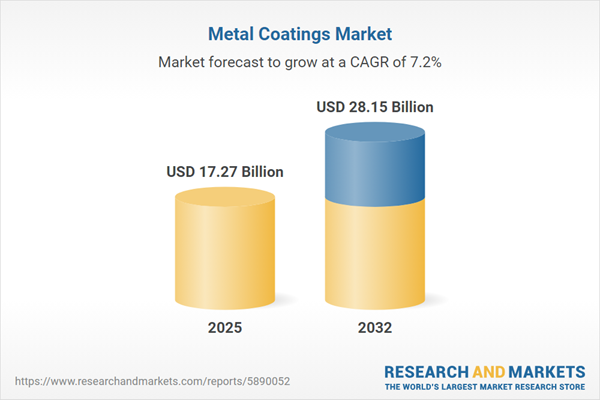Speak directly to the analyst to clarify any post sales queries you may have.
The metal coatings market is evolving rapidly, shaped by regulatory pressures, emerging technologies, and shifting supply chain strategies. Senior decision-makers require actionable insights as the industry transforms from viewing coatings as consumables to treating them as essential drivers of operational efficiency, longevity, and compliance.
Market Snapshot: Metal Coatings Market Size and Growth Outlook
The Metal Coatings Market grew from USD 16.12 billion in 2024 to USD 17.27 billion in 2025. It is projected to reach USD 28.15 billion by 2032, reflecting a 7.21% CAGR. Market expansion is driven by increased demand across aerospace, automotive, construction, and energy, as companies prioritize asset longevity, energy efficiency, and regulatory compliance.
Scope & Segmentation: Comprehensive View of the Metal Coatings Market
- Coating Type: Acrylic, aluminum (electroplating, thermal spraying), epoxy, polyurethane, zinc (electroplating, hot dip)
- End-Use Industry: Aerospace (commercial, defense), automotive (OEM, aftermarket), construction, machinery, marine, oil & gas (upstream, downstream)
- Technology: Chemical vapor deposition (LPCVD, PECVD), electrodeposition, electroplating, hot dip, physical vapor deposition (evaporation, sputtering), thermal spraying (HVOF, plasma spray)
- Coating Form: Liquid (solvent-based, water-based), powder (thermoplastic, thermoset)
- Substrate Type: Aluminum, steel
- Regions Covered: Americas (North America: United States, Canada, Mexico; Latin America: Brazil, Argentina, Chile, Colombia, Peru); EMEA (Europe: United Kingdom, Germany, France, Russia, Italy, Spain, Netherlands, Sweden, Poland, Switzerland; Middle East: United Arab Emirates, Saudi Arabia, Qatar, Turkey, Israel; Africa: South Africa, Nigeria, Egypt, Kenya); Asia-Pacific (China, India, Japan, Australia, South Korea, Indonesia, Thailand, Malaysia, Singapore, Taiwan)
- Key Companies: The Sherwin-Williams Company, PPG Industries, Inc., Akzo Nobel N.V., Axalta Coating Systems Ltd., Nippon Paint Holdings Co., Ltd., Jotun A/S, Kansai Paint Co., Ltd., BASF SE, RPM International Inc., Hempel A/S
Key Takeaways for Senior Decision-Makers
- Sustainable formulations and waterborne chemistries are gaining traction, driven by regulatory demands and end-user requirements for lower emissions.
- Advanced application technologies, including high-velocity oxygen fuel spraying and digital process controls, are improving coating performance and operational efficiency.
- Supply chains continue to realign in response to new tariff regimes, prompting increased local production and strategic diversification of raw material sourcing.
- Regional differences matter: North America emphasizes corrosion resistance and compliance, EMEA focuses on lightweight and lifecycle solutions, and Asia-Pacific leads growth through infrastructure and machinery investments.
- Smart coatings that integrate sensors are enabling predictive maintenance, offering direct value to asset-intensive sectors by monitoring in-service conditions.
- Circular economy principles are driving innovation in material reclamation and product lifecycle strategies, supporting both environmental targets and cost containment.
Tariff Impact: Recent United States Tariff Changes
The introduction of the 2025 United States tariffs on metallic inputs and coating formulations has resulted in immediate supply chain adjustments. Companies are increasing reliance on domestic and alternative suppliers while balancing cost management through negotiated contracts. These market dynamics are promoting investments in local production capabilities and spurring development of reformulated coating chemistries less affected by tariff-related fluctuations.
Methodology & Data Sources
Findings are informed by a multistage methodology combining literature review, structured interviews with industry leaders, and on-site manufacturing observations. Data integration processes and validation reviews ensure that performance benchmarks, operational practices, and emerging technology trends are accurately reflected. This robust approach guarantees actionable and verifiable insights.
The Metal Coatings Market: Why This Report Matters
- Supports informed investment, procurement, and strategy decisions by detailing evolving commercial, regulatory, and technology landscapes
- Enables benchmarking against global leaders and regional competitors while identifying risks and opportunities for sustainable growth
- Equips stakeholders with clarity on transformative trends, including supply chain resilience and adoption of smart, sustainable coating solutions
Conclusion
Senior leaders in the metal coatings market face a pivotal juncture as technology, sustainability, and trade realign the competitive landscape. This report delivers the critical knowledge necessary for strategic planning and sustained market advantage.
Additional Product Information:
- Purchase of this report includes 1 year online access with quarterly updates.
- This report can be updated on request. Please contact our Customer Experience team using the Ask a Question widget on our website.
Table of Contents
3. Executive Summary
4. Market Overview
7. Cumulative Impact of Artificial Intelligence 2025
Companies Mentioned
The companies profiled in this Metal Coatings market report include:- The Sherwin-Williams Company
- PPG Industries, Inc.
- Akzo Nobel N.V.
- Axalta Coating Systems Ltd.
- Nippon Paint Holdings Co., Ltd.
- Jotun A/S
- Kansai Paint Co., Ltd.
- BASF SE
- RPM International Inc.
- Hempel A/S
Table Information
| Report Attribute | Details |
|---|---|
| No. of Pages | 186 |
| Published | October 2025 |
| Forecast Period | 2025 - 2032 |
| Estimated Market Value ( USD | $ 17.27 Billion |
| Forecasted Market Value ( USD | $ 28.15 Billion |
| Compound Annual Growth Rate | 7.2% |
| Regions Covered | Global |
| No. of Companies Mentioned | 11 |









